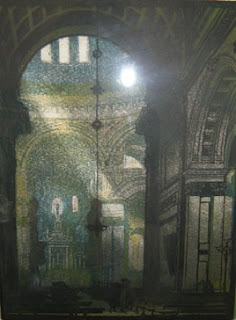Emile Antoine Verpilleux (I).
(1888-1964)
British painter, portraitist,
woodengraver, illustrator and
Modern Printmaker
British painter, portraitist,
woodengraver, illustrator and
Modern Printmaker
His first 5 modern prints.
The most
actual and condensed biography on E.A.Verpilleux can be found here in Art and the Aesthete.
The exemplary and legendary but sadly late Blog of Clive. I can only encourage reading his great
and informative posting. My postings around the Antwerp School of Printmaking are an attempt showing some things that maybe haven’t been shown or discussed
before on the web.
Born from
Belgium parents in London Emile was trained in the Antwerp Royal Academy but started his artistic training in London. Initially, undoubtedly, as a painter. Guessing
he must have been around 18 leaving for Antwerp leads us to around 1905-07. Around
the year Edward Pellens, was appointed director-professor. Again
guessing he will have stayed in Antwerp for maybe 4-5 years, most students stayed 4 but Emile, because of his already noticed talents was granted a state (post doc) stipendium. We find him actually
back in London in January 1911, mentioned in the
London Illustrated.
The
prestigious Studio Magazine published a major article by James Bolivar Manson (1879-1945, reading this later Tate director’s biography here is a must) on young
Emil Verpilleux in the September 1913 edition. Showing “his latest” two prints
in full color: “St. Pauls from Cheapside” and “St. Pancras station” both dated
1912. Also his ”Interior of St. Pauls
Cathedral”, shown in black and white, and the mentioning and praising of “Interior
of King’s College Chapel”.
His 1912 print “the Tower Bridge” was printed in color four months earlier in the May 1913 edition. So 5 of his prints at least can be dated with some accuracy as early as 1912-1913.
His 1912 print “the Tower Bridge” was printed in color four months earlier in the May 1913 edition. So 5 of his prints at least can be dated with some accuracy as early as 1912-1913.
 |
| E.A.Verpilleux: St. Pauls from Cheapside 1912 note the window screenes lower right and the fotograph below. |
 |
| Cheapside 1910 |
 |
| E.A.Verpilleux, Tower Bridge in London Fog, 1912 Note the lantern (left) and see were Frank Brangwyn stood sketching Tower Bridge (below) at a slightly different perspective. |
 |
| Tower Bridge, Frank Brangwyn |
 |
| Tower Bridge, Luigi Kasimir |
 |
| A foggy day in London Town , 2011 |
 |
| Claude Monet: Gare St. Lazare Paris 1877 |
 |
| Yoshijiro Urushibara (after Frank Brangwyn) |
 |
| The railway engine: Frank Brangwyn. |
To be continued soon.
Suggestions and comments welcome!




Verpilleux: merveilleux!! ;-)
ReplyDeleteVery well put Elmer, thank you.
ReplyDeleteAll this comparative stuff is very telling. It just shows that part of any originality is the way he cooses his subjects!
ReplyDeleteCharles
You're absolutely right. I think that the careful composing and arranging the scenes like a stage as he did is what makes them really standing out.
ReplyDelete